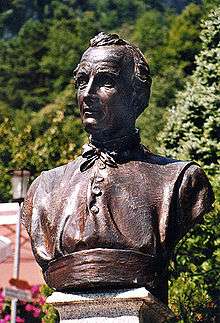Bauen
| Bauen | ||
|---|---|---|
|
| ||
| ||
 Bauen | ||
|
Location of Bauen  | ||
| Coordinates: 46°56′N 8°34′E / 46.933°N 8.567°ECoordinates: 46°56′N 8°34′E / 46.933°N 8.567°E | ||
| Country | Switzerland | |
| Canton | Uri | |
| District | n.a. | |
| Government | ||
| • Mayor |
Präsidentin Gemeinderat Françoise Planzer (as of 2008) | |
| Area[1] | ||
| • Total | 3.78 km2 (1.46 sq mi) | |
| Elevation | 436 m (1,430 ft) | |
| Population (Dec 2015[2]) | ||
| • Total | 158 | |
| • Density | 42/km2 (110/sq mi) | |
| Postal code | 6466 | |
| SFOS number | 1204 | |
| Surrounded by | Flüelen, Isenthal, Seelisberg, Sisikon | |
| Website |
www SFSO statistics | |
Bauen is a municipality on Lake Lucerne in the Swiss canton of Uri.
History
Bauen is first mentioned in 1150 as Bawen.[3]
Geography

Bauen has an area, as of 2006, of 3.8 km2 (1.5 sq mi). Of this area, 13.5% is used for agricultural purposes, while 74.9% is forested. Of the rest of the land, 2.9% is settled (buildings or roads) and the remainder (8.7%) is non-productive (rivers, glaciers or mountains).[4] In the 1993 land survey, 68.3% of the total land area was heavily forested, while 0.8% is covered in small trees and shrubbery. Of the agricultural land, 1.8% is used for farming or pastures, while 10.3% is used for orchards or vine crops and 1.3% is used for alpine pastures. Of the settled areas, 2.1% is covered with buildings, 0.5% is industrial, and 0.3% is transportation infrastructure. Of the unproductive areas, 0.3% is unproductive standing water (ponds or lakes), 1.6% is unproductive flowing water (rivers), 4.2% is too rocky for vegetation, and 2.6% is other unproductive land.[5]
The village lies on the west side of the Urner lake, which is part of the bigger lake Vierwaldstättersee or the Lake of the Four Forest Cantons. Until 1956 the only way to reach the village was over steep footpaths from the neighboring communities.
Because of its position on the lake and the Föhn wind, Bauen has a very mild climate.
Demographics
Bauen has a population (as of 31 December 2015) of 158.[6] As of 2007, 8.7% of the population was made up of foreign nationals. Over the last 10 years the population has decreased at a rate of -14.1%. Most of the population (as of 2000) speaks German (99.1%), with Italian being second most common ( 0.4%) and Czech being third ( 0.4%).[4] As of 2007 the gender distribution of the population was 48.7% male and 51.3% female.[7]
The entire Swiss population is generally well educated. In Bauen about 75.6% of the population (between age 25-64) have completed either non-mandatory upper secondary education or additional higher education (either university or a Fachhochschule).[4]

Bauen has an unemployment rate of 0.76%. As of 2005, there were 16 people employed in the primary economic sector and about 8 businesses involved in this sector. 7 people are employed in the secondary sector and there are 3 businesses in this sector. 44 people are employed in the tertiary sector, with 7 businesses in this sector.[4]
The historical population is given in the following table:[3]
| year | population |
|---|---|
| 1799 | 115 |
| 1850 | 175 |
| 1900 | 167 |
| 1950 | 194 |
| 1970 | 157 |
| 2000 | 228 |
| 2005 | 192 |
| MARCH 2014 | 176 |
Coat of arms
First mentioned in 1849, the flag or coat of arms shows elk horns in gold with ten red flames along the horns tips with a bigger red flame over the head, on a black background. Originally made in 1843, the coat of arms comes from an idea of St. Idda von Fischingen, whose church choir had the symbol of an elk with flaming horns. This goes back to around 1812 when the church was inaugurated. The oldest coat of arms still intact hangs in the old guardhouse from Bauen to see.
Notable residents
Alberich Zwyssig, the composer of the Swiss psalm "Trittst im Morgenrot daher", was born in Bauen. A bust of him is located in front of the village church.
References
- ↑ Arealstatistik Standard - Gemeindedaten nach 4 Hauptbereichen
- ↑ Swiss Federal Statistical Office - STAT-TAB, online database – Ständige und nichtständige Wohnbevölkerung nach institutionellen Gliederungen, Geburtsort und Staatsangehörigkeit (German) accessed 30 August 2016
- 1 2 Bauen in German, French and Italian in the online Historical Dictionary of Switzerland.
- 1 2 3 4 Swiss Federal Statistical Office Archived January 5, 2016, at the Wayback Machine. accessed 08-Sep-2009
- ↑ Canton Uri - Ground use statistics (German) accessed 8 September 2009
- ↑ Swiss Federal Statistical Office - STAT-TAB, online database – Ständige und nichtständige Wohnbevölkerung nach institutionellen Gliederungen, Geburtsort und Staatsangehörigkeit (German) accessed 30 August 2016
- ↑ Uri Population statistics (German) accessed 8 September 2009
External links
- Official Website of Bauen
- Bauen in German, French and Italian in the online Historical Dictionary of Switzerland.
- Private website from a citizen of Bauen * A multimediashow. Both in German.
| Wikimedia Commons has media related to Bauen. |

